Bamboo Scaffolding: Bamboo Poles, Green Netting
The use of bamboo scaffolding offers a peek inside Hong Kong’s economic development and religious landscape.
Written by Lok Hang Fung
Published on 05/08/2021
The cityscape of Hong Kong is characterised by an array of gigantic tall buildings, busy roads and super fast walkers. If you walk through one of the vibrant streets and look up the sky, chances are you would be greeted by platforms and structures formed by a combination of bamboo poles, knots tied with nylon straps (or bamboo splints 竹篾 before the mid-1970s),[1] and the extraordinary skills of scaffolding practitioners (honorifically called si1 fu2; shifu 師傅). These are bamboo scaffolds (竹棚), a technique originated in China allegedly over 5000 years ago,[2] flourished in Southern China where high-quality bamboos grow, but preserved only in Hong Kong. Today, Hong Kong is the only place in the world where bamboo scaffolding is still commonly used.
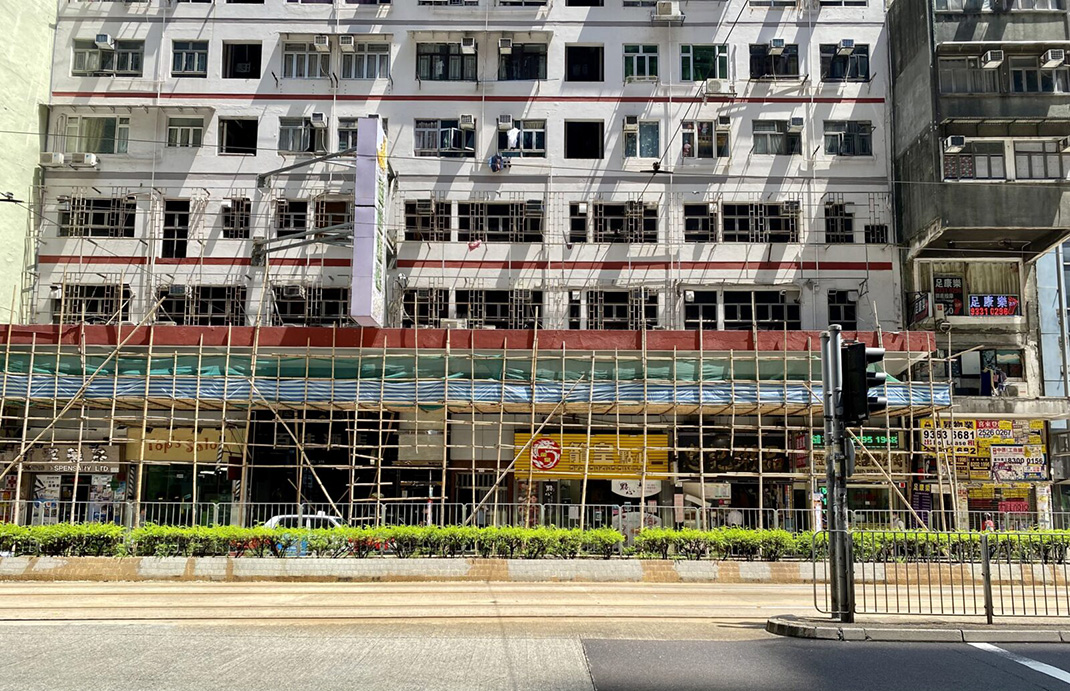
Bamboo scaffolding was and still is used in a wide variety of ways. Engraved bricks in Han Dynasty tombs already showed images of “peng ge” (棚閣 scaffolds), bamboo structures erected for construction work.[3] In the Sui and Tang dynasties, during festive seasons, residents of major cities would gather together in front of temporary bamboo sheds to enjoy performances. In the magnificent Chinese scroll painting Along the River During the Qingming Festival (清明上河圖) dated in the Northern Song Dynasty, bamboo sheds of all kinds: little stores, canopies, and ceremonial archways can be spotted. During jiao (醮) festivals, until today, bamboo theatres are set up all around Hong Kong even in the most remote areas, including Po Toi, the southernmost island of Hong Kong. Fast growing, durable, light in weight and inexpensive, bamboo is the best material for building temporary structures.
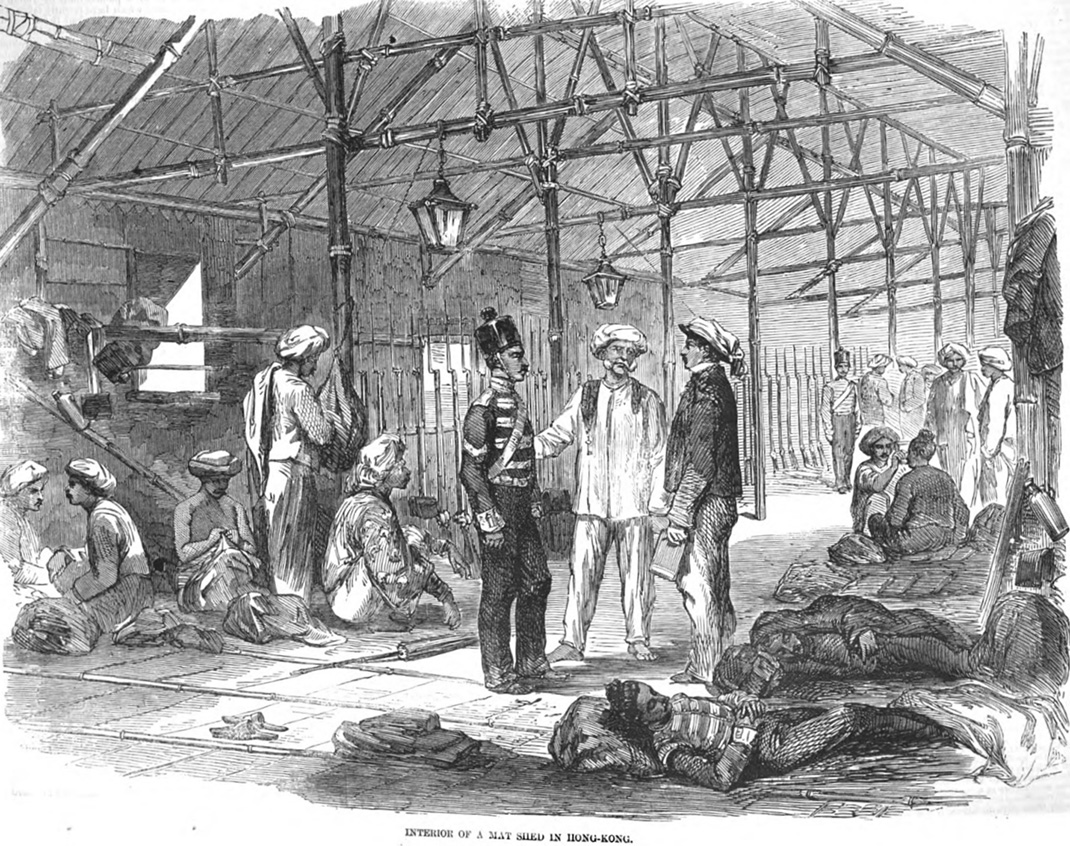
While it is not clear when exactly had the skill of bamboo scaffolding been adopted in Hong Kong, the technique has its roots in the Sui-Tang dynasties mobile theatre, and Hong Kong’s Nanyue (南越/粵) legacy – in the Yue region where bamboos grow well, the Yue people constructed stilt houses with bamboos to adapt to the rainy and humid climate and to prevent vermin and pests from entering.[4] It is no surprise that the craft of bamboo scaffolding flourished only in Southern and coastal China, where the kinds of bamboo (Mao Jue 毛竹 and Kao Jue 篙竹) used in bamboo scaffolding are commonly grown. The area is also characterised by highly developed water transport systems (so that bamboo can be transported) and prosperous economic development (so that bamboo scaffolds are much needed for construction works and jiao theatres). Then here comes the question. Why is bamboo scaffolding only preserved in Hong Kong?
In the late 1940s and 1950s, the civil war and the subsequent change of political regime led to an influx of refugees from mainland China to Hong Kong, a British colony which was relatively safe and stable. Hong Kong’s population increased by more than one million from 1946 to 1956,[5] and an astonishing 40% of the increase came from migration.[6] Squatter shacks (寮屋) built with tin, wood or cardboards started sprawling the periphery of urban areas to accommodate the newly arrived. Imaginably, living conditions were unpleasant, and deadly squatter fires were not uncommon.[7] The most serious fire happened on Christmas day in 1953 – the Shek Kip Mei fire left 58,000 people homeless overnight, and was the catalyst to resettlement attempts that began before the year. Multi-storey Resettlement Estates (徙置區) started to be constructed, marking the beginning of the Hong Kong public housing system.
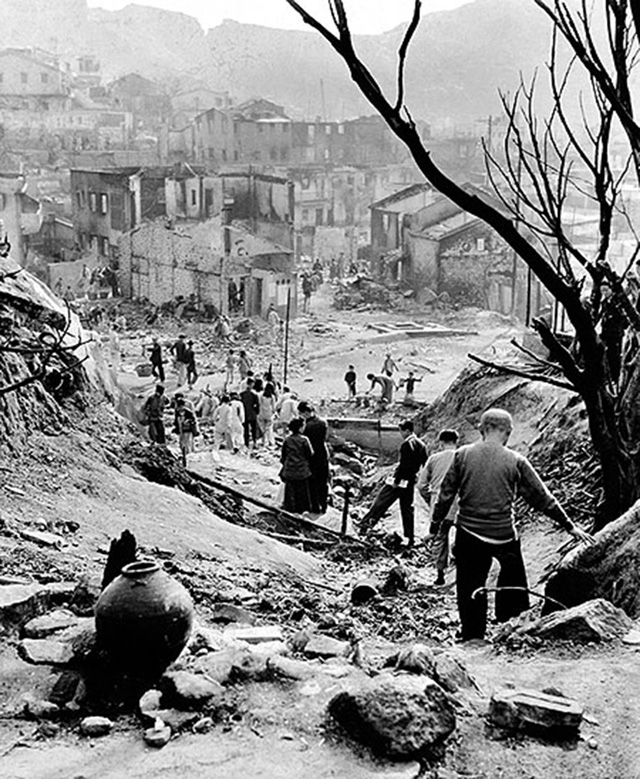

In the meantime, workers and entrepreneurs (among them were Shanghainese construction elites who had excellent experiences operating large-scale projects)[8] who had just fled mainland China provided Hong Kong the skills and manpower just in need. All these factors created the perfect backdrop for the property development boom in Hong Kong in the 1960s. The bamboo scaffolding industry flourished thanks to this property boom in Hong Kong (don’t forget that mainland China was still struggling with massive famine and the Cultural Revolution in the 1960s).
Today, bamboo scaffolding is largely eliminated outside of Hong Kong due to safety concerns and a lack of scaffolding professionals (many have migrated or changed professions during and after the political turbulence), but the technique survived in Hong Kong not only because “it’s always how things work”. Compared with metal scaffolds, bamboo scaffolds have a definite competitive advantage in terms of time, cost, and flexibility. Bamboo is much lighter than steel, which means it is also much easier to handle for workers. Unlike metal scaffolds of which installation requires heavy manpower, machinery and tools, all it takes to erect bamboo scaffolds are just simple hand tools and nylon ties. The result? Bamboo scaffoldings are six to eight times faster to be installed;[9] and dismantling is even faster – steel scaffolds take almost the same amount of time to erect and to take down; but dismantling bamboo scaffolds only require one-tenth the time it is set up.[10]
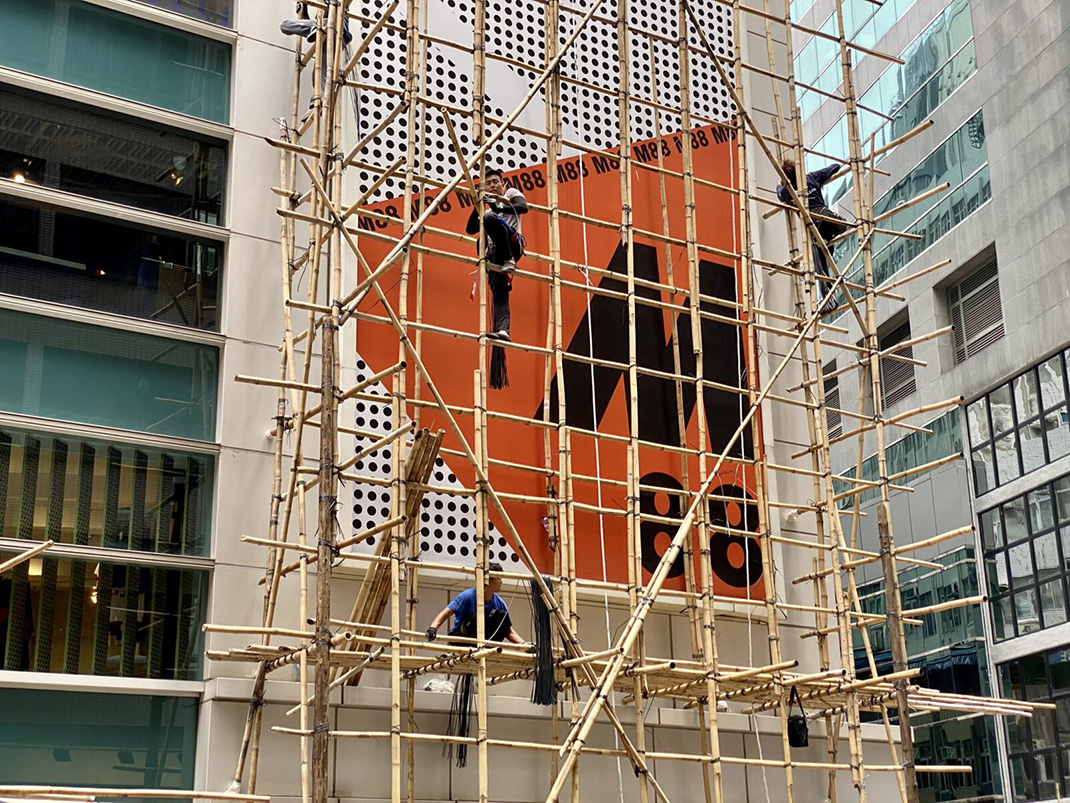
As bamboo scaffolds are much more efficient to handle, instal and dismantle, it is easy to imagine that they are also a lot cheaper. In fact, bamboo poles as a material are initially much cheaper than steel poles. Data from 2002 shows that a 6m-long bamboo pole costs HKD10, compared with HKD80 of a steel pole of similar size.[11] Bamboo poles are also cheaper because they are easier to store and maintain. Metal poles must be oiled, painted and stored under cover, while bamboo poles do not need any of these. On the streets of Hong Kong, it is not hard to find bamboo poles placed casually next to construction sites, precisely because no special care has to be given, and there is no theft concern either.

Last but not least is flexibility. Metal scaffolds are pre-made or rented off-site, while bamboo scaffolds are erected by si fu onsite according to their experiences and judgements. The si fu would, depending on the different venues and needs, decide how the bamboo scaffolds should be set up. Bamboo poles can be trimmed onsite, or longer poles can be used conveniently. This gives bamboo scaffolds the flexibility to accommodate different construction and/or maintenance needs. There are so many different forms of bamboo scaffolds, usually with minor differences in specifications (types of bamboo or supporting tools used) for different uses and different circumstances.
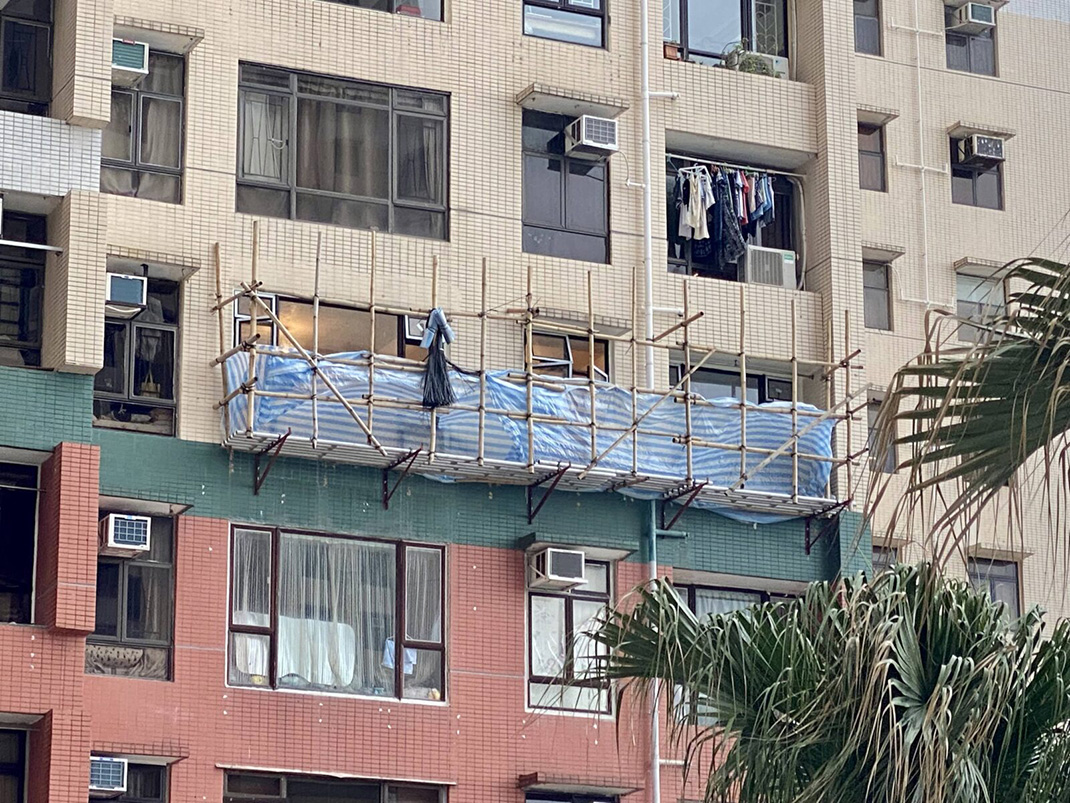
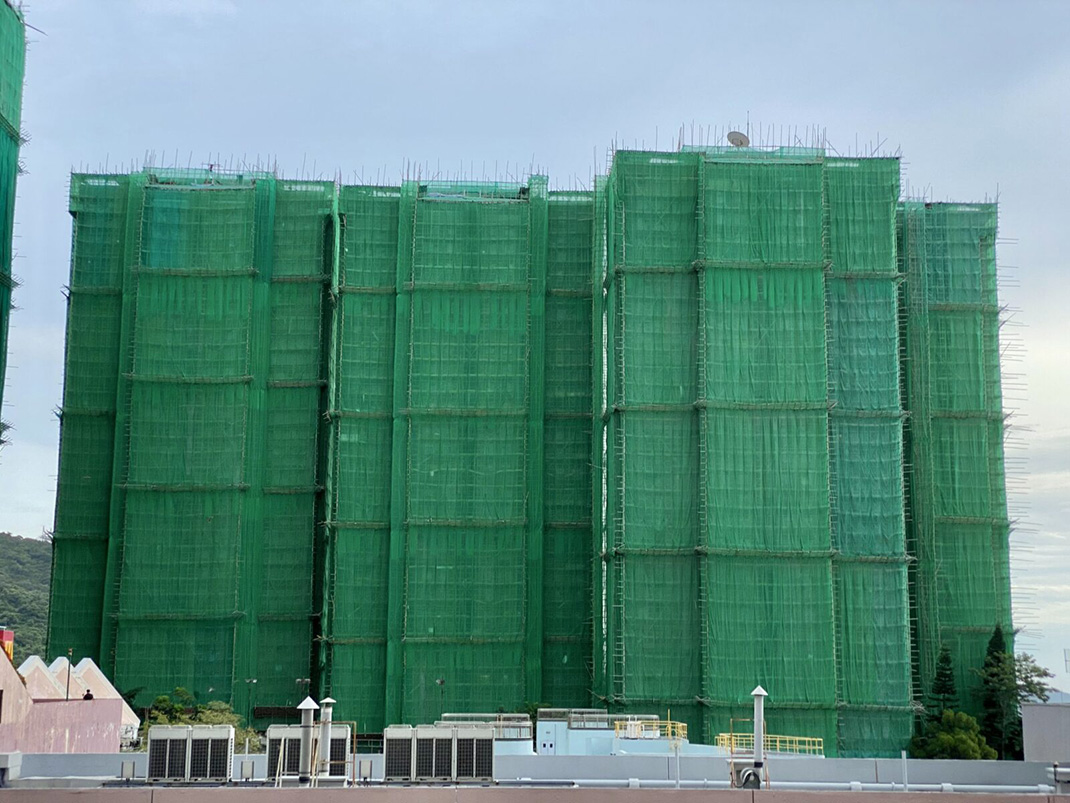
Apart from construction and/or maintenance work, as mentioned above, bamboo theatres are also a common usage of bamboo scaffolds in Hong Kong. During festivals including birthdays of deities (e.g. Buddha’s birthday 佛誕 or Tin Hau’s birthday 天后誕) or the Ghost Festival (盂蘭節), bamboo theatres would be set up to house performances (神功戲) by professional Cantonese or Chiu Chow opera troupes. Because of the flexibility of bamboo scaffolds, bamboo theatres can be erected even in the most difficult scenario and the most remote areas. Although performances are mainly for entertaining deities, bamboo theatres are also where the community gather together and enjoy free entertainment. They are hence an important component of Hong Kong people’s religious and social life.
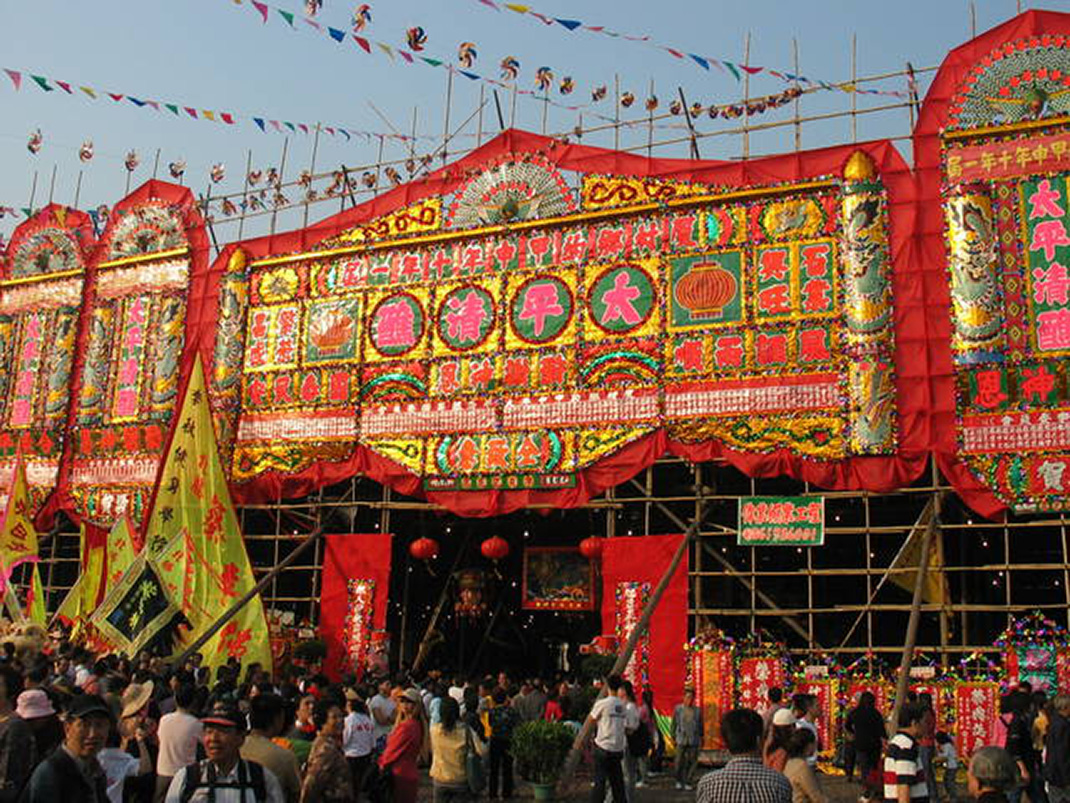
“Borrowed place, borrowed time”. Bamboo poles and green netting are perhaps symbols of the in-betweenness and temporarity of Hong Kong, where the new are always built; and the old are continuously torn down. Even the bamboo scaffolding industry itself is faced with increasing challenges. In recent years, the mixed use of mental poles with bamboo poles in scaffold structures is more and more common; and for reasons including higher stability and longer durability (mental scaffolds can be reused for 10 years while bamboo poles can only be reused for around 15 months), the use of mental scaffolding is increasing. On the other hand, the construction of bamboo theatre is faced with issues of labour shortage, mainly due to employment instability of the industry. For example, because of the pandemic, many Chinese festival celebrations in 2020 were cancelled. Coupled with the arduous and physically demanding nature of the job, it is not impossible that the craft of bamboo theatre will disappear one day.
The backbone of the Hong Kong construction industry for more than five decades, bamboo poles have supported the construction of countless skyscrapers and homes of many. They are so ubiquitous and so everyday to an extent that they become almost unnoticeable. Yet, they also offer much about the depth of the history of Hong Kong and the lives of Hong Kong people.
Footnotes
- Ramanathan, Muthukaruppan. “Hong Kong – Bastion of Bamboo Scaffolding.” Proceedings of the Institution of Civil Engineers – Civil Engineering 161, no. 4 (2008): 177-83.
- Waters, Dan. “THE CRAFT OF THE BAMBOO SCAFFOLDER.” Journal of the Hong Kong Branch of the Royal Asiatic Society 37 (1998): 19-38.
- Chan Chui-yi 陳翠兒, and Choi Wun Hing 蔡宏興, Xianggang jianzu bainian 香港建築百年 [A Century of Hong Kong Architecture] (Hong Kong: Joint Publishing Hong Kong, 2012), 133.
- Tse, Yin-mo 謝燕舞, Xiaokou 小口, and Sze-man Poon 潘詩敏. Peng, Guan, Ji: Guan Yu Zhu Peng, Xi Qu Ji Shi Ji Wen Hua De Tan Suo 棚・ 觀・集 : 關於竹棚、戲曲及市集文化的探索 [Scaffolding, viewing, assembling : cultural observations on bamboo scaffolding, Chinese opera and markets]. Hong Kong: Yi shu yan jiu she, 2010.
- Hong Kong Statistics 1947–1967 (PDF) (Report). Census and Statistics Department. 1969. https://www.statistics.gov.hk/pub/hist/1961_1970/B10100031967AN67E0100.pdf
- Fan, Shuh Ching (1974). “The Population of Hong Kong” (PDF). World Population Year: 1–2. http://www.cicred.org/Eng/Publications/pdf/c-c21.pdf
- Smart, Alan. The Shek Kip Mei Myth. Hong Kong: Hong Kong University Press, 2006.
- Ho, Pui Yin. Becoming Hong Kong Development History of Construction Industry 1840-2010. 1st ed. Hong Kong: Commercial Press (H.K.), 2010, 150.
- Ramanathan, Muthukaruppan. “Hong Kong – Bastion of Bamboo Scaffolding.” Proceedings of the Institution of Civil Engineers – Civil Engineering 161, no. 4 (2008): 177-83.
- Yu, W. K., K. F. Chung, and S. L. Chan. “Axial Buckling of Bamboo Columns in Bamboo Scaffolds.” Engineering Structures 27, no. 1 (2005): 61–73.
- So, Francis. “Erection of Bamboo Scaffolds and Their Recent Developments.” In Advances in Building Technology, edited by M. Anson, J. M. Ko and E. S. S. Lam, 645-51. Oxford: Elsevier, 2002.
